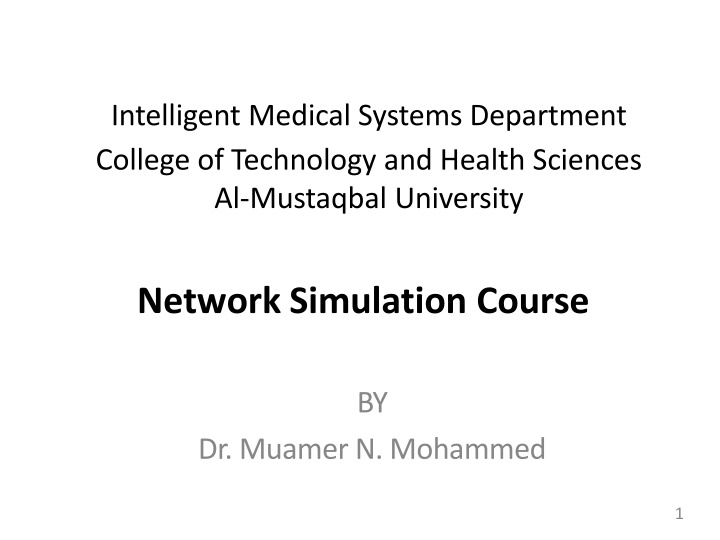
Advanced Network Simulation Course for Technology and Health Sciences at Al-Mustaqbal University
"Explore the Intelligent Medical Systems Department's network simulation course at Al-Mustaqbal University, covering topics like VLANs, network protocols, Cisco devices, and more. Enhance your skills in configuring switches and routers for LAN and WAN services. Prerequisites include knowledge of network terms, protocols, and Windows usage."
Download Presentation

Please find below an Image/Link to download the presentation.
The content on the website is provided AS IS for your information and personal use only. It may not be sold, licensed, or shared on other websites without obtaining consent from the author. If you encounter any issues during the download, it is possible that the publisher has removed the file from their server.
You are allowed to download the files provided on this website for personal or commercial use, subject to the condition that they are used lawfully. All files are the property of their respective owners.
The content on the website is provided AS IS for your information and personal use only. It may not be sold, licensed, or shared on other websites without obtaining consent from the author.
E N D
Presentation Transcript
Intelligent Medical Systems Department College of Technology and Health Sciences Al-Mustaqbal University Network Simulation Course BY Dr. Muamer N. Mohammed 1
Lecture1 Introduction 2
Course Objectives Upon completion of this course, you will be able to perform the following tasks: Determine when to use a hub, Ethernetswitch, or multiprotocol router Use Cisco software to identify interfaces, protocols, addresses, andconnectivity Interconnect switches and routers according to a specification Configure switches and routers to support LAN and WAN services 3
Course Objectives (cont.) Set up IP subnet addressing and address utilitiesfor effective networkadministration Configure access lists to control access to devices or network segments Verify that switches, routers, and theirconfigured network services operate as intended Recognize a network problem, identify the source of the problem, and resolveit 4
Course Topics VLAN 3 VLAN 1 Legend FastEthernet/ Ethernet ISDN Dedicated ISL ISL VLAN 2 VLAN 1 ISL ISL Core_Server LeasedLine/ Frame Relay ISDN Cloud 5
Prerequisites Know commonly used network terms and topologies Know the basic function of a network protocol Fundamental network device roles Understand the layers of the ISO/OSI Reference model Use Windows 95/NT to run multiple applications Exposure to the Internet or an intranet Basic ability with binary and hexadecimal numbering Interconnecting Cisco Network Devices (ICND) 6
Sources of Information Student kit www.cisco.com CD-ROM Cisco Press 7
Course Syllabus Module 1 Module 2 Module 3 Module 4 InterconnectingCisco Network Devices Introduction CatalystSwitch Operations Interconnecting Networks with TCP/IP EstablishingSerial Point-to-Point Connections Extending Switched Networkswith VirtualLANs Internetworking ConceptsOverview Completing an ISDN BRI Call Determining IP Routes Assembling and Cabling CiscoDevices Establishing a Frame RelayPVC Connection Basic IP Traffic Managementwith Access Lists Operating and Configuring aCisco IOS Device ConfiguringNovell IPX Managing Your Network Environment 8
Graphic Symbols Network switch Access server Bridge Switch ISDN switch Multi-layer switch Router DSU/CSU Personal computer File Server Data Service Unit/ Channel Service Unit Modem Web Server WAN cloud Hub Network Cloud or Broadcast Domain VLAN (Color May Vary) Ethernet Fast Ethernet Serial Line Circuit Switched Line 9 Dr.Eng.Mohamed.I.Shujaa









